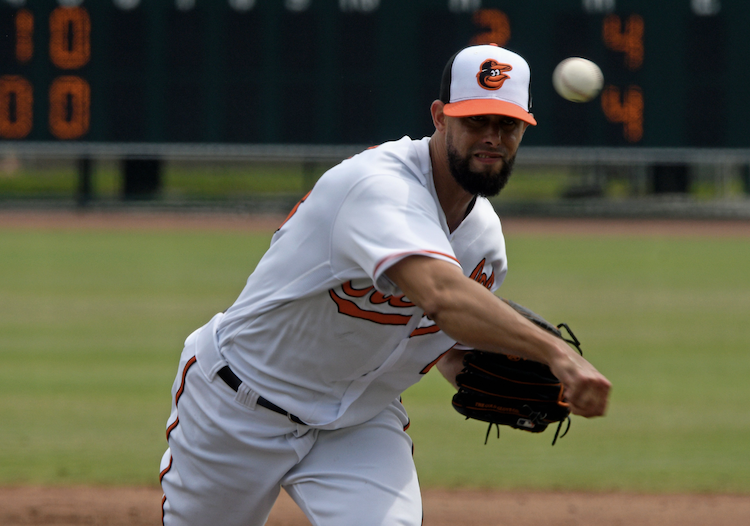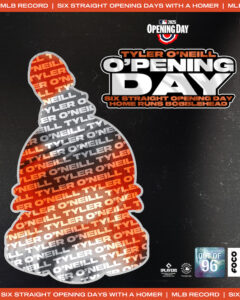Jorge Lopez is in the middle of an excellent season. He was a player that the Orioles kept in the rotation far too long but who is thriving in the bullpen this season. He is averaging more than an inning per appearance. His ERA is 0.79. He has yet to give up a homer and he has an outstanding ground ball rate. He is 4th in all of baseball, amongst relievers in Win Probability Added (WPA).
He also has some impressive batted ball data. Exit velocity against him is over two MPH slower than league average. His xWOBA is .260, which is almost 60 points below league average. His hard hit% is 10% below league average. Launch angle against him is 0.2, whereas the league average is 12.1. His GB rate is 63.5%. It is no wonder why he hasn’t given up a homer, as opponents aren’t hitting the ball hard, or in the air.
Before discussing Lopez more, I want to go back to the 2014 season and Zach Britton (now Zack). During that season, Britton averaged more than an inning per appearance. He had a 1.65 ERA. He had a very low homer rate and a high GB%. However, that season I talked about how I didn’t see Britton as an elite reliever, mainly because of a low K rate. He had a great year but he wasn’t elite yet. His FIP that year 3.13 and his xFIp was 2.82. Still very good but not 1.65 good. The one thing that made me believe Britton was headed for elite seasons was his swinging strike %. Britton’s swingstr% in 2014 was 21.8%, which was well above average at that time, leading me to believe that the Ks would come. In 2014, his K rate was 7.31. In 2015, It was 10.8 and in 2016 it was 9.9. Britton’s ERA in 2015 was 1.92 and his FIP was 2.01, xERA was 1.79 and his xFIP was 1.75. In 2016, his ERA was 0.54, his xERA was 1.70, his FIP was 1.94 and his xFIP was 2.09. The K rate rising took him to another level.
That brings us back to Lopez. This year, as stated, Lopez has a 0.79 ERA. His xERA is 2.42, his FIP is 2.46 and his xFIP is 3.31. These are still very good numbers but they aren’t as elite as his ERA shows him to be.
What are Jorge’s issues? Well, first of all, the walk rate is too high, sitting at 105th in MLB amongst relievers who have thrown at least 20 innings.
Secondly, the K rate is subpar for a reliever nowadays. Of the relievers who have thrown at least 20 innings this year, Lopez is 90th in K rate. Part of the issue is that he just isn’t missing enough bats. His swingstr% is 18.5%, which is about league average for all pitchers but below league average for relievers. The good news is that his K rate and swingstr% aren’t poor. They just are average-ish or slightly below.
Put it altogether and what do we have? Well, he really is a poor man’s Britton. He misses fewer bats, gets fewer ground balls, gives up a little more launch angle and hard hit balls and walks more batters. But the game plan is similar: limit the homers, keep the ball on the ground, limit the hard contact and trust your defense.
The difference is, Britton had to trust his defense a little less because opponents put fewer balls in play against him.
What it ends up meaning is that Lopez will eventually start giving up runs. It is possible that he goes through the 2022 season and keeps his ERA below 1.50. Sometimes, guys just have years like that, especially relievers. The question is, how sustainable is it and the answer is, in my opinion, that it is not sustainable long term unless he starts to miss more bats, get more Ks (remember, players are striking out a lot more now than even when Britton was the O’s closer) and walk fewer guys.
Surprisingly, despite the walks, Lopez has a str% of 64.9%, which is higher than league average. That leads you to believe the walks should come down. But if he doesn’t start to miss more bats, the K rate likely won’t rise and since he is a ground ball pitcher, eventually the balls will find holes (perhaps especially if MLB bans the shift starting next year), the baserunners will emerge, and the ERA will go up.
My thoughts are that Lopez is more of a 2.50-3.50 ERA pitcher. This is what I mean when I say his current year isn’t sustainable. Sure, not many guys can carry a sub-1.50 ERA over multiple seasons, but the truly elite guys usually won’t be much worse than that. He is still extremely valuable and a very good arm to have in the back of the pen.
The question is, do you keep him or do you trade him?
The answer, of course, is dependent on the return. If some team is actually valuing him as a guy with multiple years of control, someone cheap and someone in the midst of a sub-1 ERA season, than the return should be high and that’s a move you likely have to make. If the offers are more in line with “we need to see more to offer more,” I would be inclined to keep him.
It’s an interesting decision for Mike Elias. On one hand, the team is still not that good and figures to be fighting for a top seven or so pick in the 2023 draft. On the other, the team is playing better and are finally starting to build towards something and eventually, you have to start keeping players to win.
For me, I am dealing him if the right deal is there. The Orioles have a lot of arms that probably aren’t starters long term and they can make them relievers. I think a guy, for example, like Kyle Bradish could be an outstanding closer. I am not ready to give up on him as a starter yet but the bottom line is that he struggles with a 3rd pitch and his fastball command is shaky. He is a guy that most have pegged as a reliever throughout his professional career and he isn’t showing much to deter that as of now. I would keep throwing him out there but if the struggles continue, a change will be made. He is just an example and is someone that could be a reason you feel OK with trading Lopez.
This is a good problem to have. The Orioles are finally at a point where they don’t “have to” trade guys. They can finally say, we are keeping players because we intend to win next year (whether ownership wants it or not). They are now in a position where they can pick and choose who they deal, not worry about the money aspect (we hope) and only trade guys if the returns are big. In the past, there have been moves focusing on saving money and just freeing up space. That doesn’t need to be the case now.
What do you think? Should the Orioles trade Lopez? Is he a must keep? Will the K rate rise and he becomes a more sustainable dominant pitcher?
This is just one of many decisions Elias will have to make over the next six weeks. In the past, the mindset has been to build inventory. Is that still the mindset?









